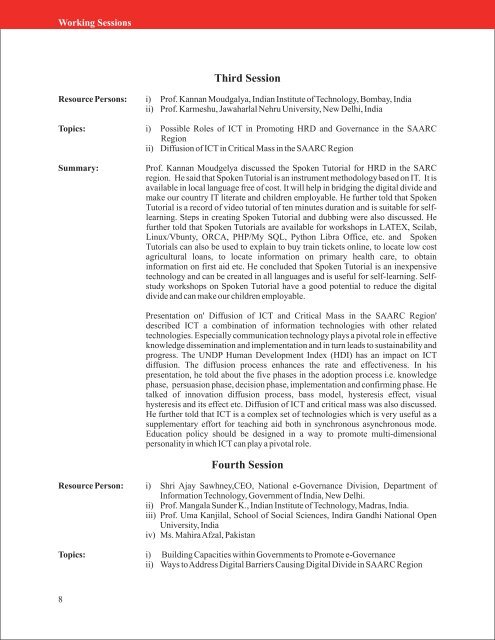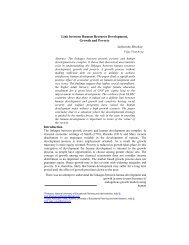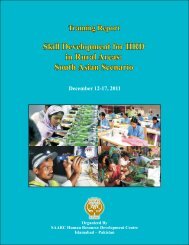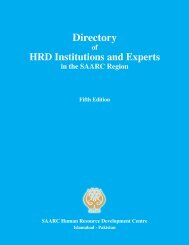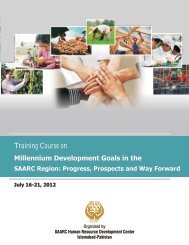Here - SAARC Human Resource Development Centre
Here - SAARC Human Resource Development Centre
Here - SAARC Human Resource Development Centre
- No tags were found...
Create successful ePaper yourself
Turn your PDF publications into a flip-book with our unique Google optimized e-Paper software.
Working SessionsThird Session<strong>Resource</strong> Persons: i) Prof. Kannan Moudgalya, Indian Institute of Technology, Bombay, Indiaii) Prof. Karmeshu, Jawaharlal Nehru University, New Delhi, IndiaTopics: i) Possible Roles of ICT in Promoting HRD and Governance in the <strong>SAARC</strong>Regionii) Diffusion of ICT in Critical Mass in the <strong>SAARC</strong> RegionSummary:Prof. Kannan Moudgelya discussed the Spoken Tutorial for HRD in the SARCregion. He said that Spoken Tutorial is an instrument methodology based on IT. It isavailable in local language free of cost. It will help in bridging the digital divide andmake our country IT literate and children employable. He further told that SpokenTutorial is a record of video tutorial of ten minutes duration and is suitable for selflearning.Steps in creating Spoken Tutorial and dubbing were also discussed. Hefurther told that Spoken Tutorials are available for workshops in LATEX, Scilab,Linux/Vbunty, ORCA, PHP/My SQL, Python Libra Office, etc. and SpokenTutorials can also be used to explain to buy train tickets online, to locate low costagricultural loans, to locate information on primary health care, to obtaininformation on first aid etc. He concluded that Spoken Tutorial is an inexpensivetechnology and can be created in all languages and is useful for self-learning. Selfstudyworkshops on Spoken Tutorial have a good potential to reduce the digitaldivide and can make our children employable.Presentation on' Diffusion of ICT and Critical Mass in the <strong>SAARC</strong> Region'described ICT a combination of information technologies with other relatedtechnologies. Especially communication technology plays a pivotal role in effectiveknowledge dissemination and implementation and in turn leads to sustainability andprogress. The UNDP <strong>Human</strong> <strong>Development</strong> Index (HDI) has an impact on ICTdiffusion. The diffusion process enhances the rate and effectiveness. In hispresentation, he told about the five phases in the adoption process i.e. knowledgephase, persuasion phase, decision phase, implementation and confirming phase. Hetalked of innovation diffusion process, bass model, hysteresis effect, visualhysteresis and its effect etc. Diffusion of ICT and critical mass was also discussed.He further told that ICT is a complex set of technologies which is very useful as asupplementary effort for teaching aid both in synchronous asynchronous mode.Education policy should be designed in a way to promote multi-dimensionalpersonality in which ICT can play a pivotal role.Fourth Session<strong>Resource</strong> Person: i) Shri Ajay Sawhney,CEO, National e-Governance Division, Department ofInformation Technology, Government of India, New Delhi.ii) Prof. Mangala Sunder K., Indian Institute of Technology, Madras, India.iii) Prof. Uma Kanjilal, School of Social Sciences, Indira Gandhi National OpenUniversity, Indiaiv) Ms. Mahira Afzal, PakistanTopics: i) Building Capacities within Governments to Promote e-Governanceii) Ways to Address Digital Barriers Causing Digital Divide in <strong>SAARC</strong> Region8


